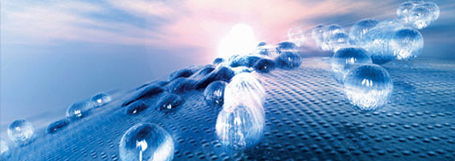
Forget what you heard about the types of prints, colors and textures that will be featured next in textile and material design-just remember this word: Waterproof. The Ion-Mask enhancement is a new plasma technology devised by P2i, a company that’s part of the UK Ministry of Defense’s programme of commercialization of government technologies. P2i uses “patented plasma technology to treat everyday objects with an invisible mask that repels oil and water, without altering the look or feel of the treated object…invisible to the eye and undetectable to touch”. When using the plasma, essentially all liquids that touch the object simply bead up on the surface instead of soaking or wetting the object. Moreover, the process for creating the plasma is environmentally friendly.
What’s incredible is that this technology can be applied to textiles, footwear, filtration systems and bio-consumables. The ability to use the technology on so many manufactured products ensures that it will have a great impact on fashion, home design, footwear and engineering systems. Simply put: its forecasted popularity is due to the fact that it uses an eco-method to create a variety of more efficient products that have added value. Sneakers you can wear in the rain, shirts you can simply wipe spilt drinks off of and unique shower curtains. Makes me want to get a waterproof blouse and pour a glass of wine on myself.

A little more about how this new technology differs itself from traditional waterproofing methods:
Textile and footwear: “Traditionally, textile waterproofing techniques have relied on extra layers which act as a suffocating barrier; or the chemical treatment of the material, which leaves the edges and seams created during the manufacture of the product exposed. Plasma technology works at a molecular level to change the way the surface reacts to liquids, delivering waterproof performance without inhibiting the circulation of air through the fabric for an effective, comfortable result.”
Filtration: “The effective performance and longevity of such products are dictated by the interaction of their surface with liquid. Traditionally, this relationship has been improved with complex chemical coatings cured at high temperatures, additives introduced during the melt process or chemical dips following an electrical discharge, but there are inherent problems with all of these methods. Plasma technology can treat 3D objects, manufactured from different materials with complex shapes, with a low-cost, universal process. This extends the life of the product, particularly in harsh environments, by vastly improving resistance to oil and liquid.”
Bio-Consumables: “Despite their inherent hydrophobicity, the materials from which products such as pipettes, petri dishes and microplates are manufactured do retain residual amounts of liquid – resulting in inaccurate test results and the waste of costly reagents. Currently, some manufacturers offer low-retention products which are achieved either by polishing the moulds to ensure minimal surface tension, introducing additives into the melt polymer before moulding or using a post-manufacture dip. While these approaches vary in effectiveness, ease of use and consistency, ion-mask™ treated consumables significantly outperform them all.”
* * *
![]()
TrendsSpotting.com is a trends agency focused on developing exciting tools for Trend Spotting. We follow current trends and are constantly looking for new ones. We specialize in trends research and the social media. Dr. Taly Weiss, TrendsSpotting CEO, is a Social Psychologist, with extensive experience in branding strategy and marketing research. Feel free to explore our trend spotting tools on www.trendoScope.com.
kindly send me more information on your product… thanks
wyejoon@hotmail.com